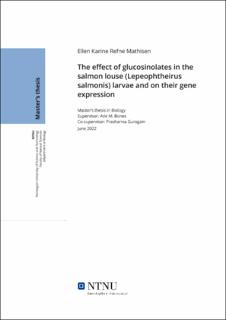| dc.contributor.advisor | Bones, Atle M. | |
| dc.contributor.advisor | Guragain, Prashanna | |
| dc.contributor.author | Mathisen, Ellen Karine Refne Mathisen | |
| dc.date.accessioned | 2022-07-15T17:21:30Z | |
| dc.date.available | 2022-07-15T17:21:30Z | |
| dc.date.issued | 2022 | |
| dc.identifier | no.ntnu:inspera:104135638:23174223 | |
| dc.identifier.uri | https://hdl.handle.net/11250/3005960 | |
| dc.description.abstract | Lakselusen (Lepeophtheirus salmonis) er en ektoparasitt som infiserer ulike laksearter som laks (Salmo salar), sjøørret (Salmo trutta), røye (Salvelinus alpinus) og regnbueørret (Oncorhynchus mykiss). Lakselus utgjør en økonomisk trussel mot oppdrettsnæringen og lakslusinfeksjoner har en negativ påvirkning på både oppdretts- og villaksens helse og velferd. Biopestisider har en naturlig biologisk opprinnelse og kan brukes som et hjelpemiddel for å regulere skadedyr og sykdom i landbruket. Biopestisider kan muligens også være nyttige i havbruksnæringen. Glukosinolater er en gruppe sekundære plantemetabolitter. De finnes hovedsakelig i familien Brassicaceae og fungerer som en del av plantens forsvar. Å benytte seg av glukosinolater som et biopestisid er derfor en mulighet, og kan kanskje være en del av løsningen på lakselusproblemet.
I dette forsøket ble glukosinolatet sinigrin og derivatet AITC brukt for å undersøke effekten de kan ha på lakseluslarver og uttrykket av et utvalg gener. Gener relatert til immunresponser, cellesyklusen, negativ regulering av celleproliferasjon, DNA-replikasjon og celledeling, og detoksifisering ble undersøkt. Studien viste at antallet aktive lus avtar med høyere konsentrasjoner av sinigrin og lenger eksponering. EtOH og AITC immobiliserte alle lusene i prøven. Genetiske analyser viste at tre gener var signifikant opp-regulert. Kopepoditter eksponert for AITC hadde en opp-regulering av genene CYP2j3 og TNFaf-4, mens hos kopepoder eksponert for sinigrin var genet GST-mu3 opp-regulert. CYP2j3 er et gen i cytokrom P450 familien. Gen i denne familien bidrar til metaboliseringen av endogene og eksogene forbindelser. TNFaf-4 modulerer en rekke responser som inflammatoriske og immun-regulerende responser, antiviral responser, celleproliferering og vekstinhibisjon. Dette studiet konkluderer ikke om sinigrin og/eller AITC påvirker L. salmonis kopepoditter, og mer forskning må til for å kunne utforske mulighetene ved bruken av glukosinolater som biopestisider. | |
| dc.description.abstract | The salmon louse (Lepeophtheirus salmonis) is an ectoparasite that infects salmonid species like Atlantic salmon (Salmo salar), sea trout (Salmo trutta), arctic char (Salvelinus alpinus) and rainbow trout (Oncorhynchus mykiss). The infection of L. salmonis causes substantial economic losses in the salmon fish farming industry and affects the health and welfare of farmed and wild salmonids. Biopesticides are compounds used to manage agricultural pests through specific biological effects, and the use of biopesticides could prove promising in the aquaculture industry. Glucosinolates are a large group of secondary plant metabolites. They are primarily found in the family Brassicaceae and are part of the plant’s defence system against herbivores. Using glucosinolates as biopesticides could be a part of the solution to conquering the salmon lice problem.
In this project, the glucosinolate sinigrin and its derivative AITC were studied for their effects on salmon louse larvae and the expression of selected genes. The expression of genes related to immune responses, cell cycle, negative control of cellular proliferation, DNA replication and cellular division, and detoxification in L. salmonis copepodites were explored. The study showed that the number of active lice decreased with higher concentrations of sinigrin and with longer time periods. EtOH and AITC completely immobilised the lice. Genetic analysis showed that only three genes were significantly up-regulated, one due to sinigrin and two due to AITC. Exposed to AITC, the copepodites showed an up-regulation of the genes CYP2j3 and TNFaf-4. Exposed to sinigrin, the copepodites showed an up-regulation of the gene GST-mu3. CYP2j3 is a member of the cytochrome P450 family, which participates in metabolising endogenous and exogenous compounds. TNFaf-4 modulates various responses, including inflammatory and immune-regulatory responses, antiviral responses, cell proliferation and growth inhibition. This study did not conclude whether sinigrin and/or AITC affect L. salmonis copepodites. Therefore, more research is needed to explore the possibilities of using glucosinolates as biopesticides against salmon lice. | |
| dc.language | eng | |
| dc.publisher | NTNU | |
| dc.title | The effect of glucosinolates in the salmon louse (Lepeophtheirus salmonis) larvae and on their gene expression | |
| dc.type | Master thesis | |
